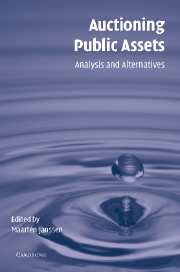Book contents
- Frontmatter
- Contents
- List of figures
- List of tables
- List of contributors
- Preface
- Introduction
- Part I Theory
- Part II Case studies
- 6 Spectrum auctions by the United States Federal Communications Commission
- 7 An analysis of the European 3G licensing process
- 8 Auctions of gas transmission access: the British experience
- 9 The design of Treasury bond auctions: some case studies
- 10 Matching markets
- 11 Competitive procurement of reintegration services in the Netherlands
- 12 The provision of rail services
- Index
- References
6 - Spectrum auctions by the United States Federal Communications Commission
Published online by Cambridge University Press: 03 December 2009
- Frontmatter
- Contents
- List of figures
- List of tables
- List of contributors
- Preface
- Introduction
- Part I Theory
- Part II Case studies
- 6 Spectrum auctions by the United States Federal Communications Commission
- 7 An analysis of the European 3G licensing process
- 8 Auctions of gas transmission access: the British experience
- 9 The design of Treasury bond auctions: some case studies
- 10 Matching markets
- 11 Competitive procurement of reintegration services in the Netherlands
- 12 The provision of rail services
- Index
- References
Summary
Introduction
In 1985 the then chairman of the Federal Communications Commission (FCC), Mark Fowler, first asked permission from the US Congress to use auctions in the assignment of spectrum licences. This request was denied. In fact, successive FCC chairmen asked Congress for this authority every year until it was finally granted in 1993. In the Omnibus Reconciliation Act of 1993, Congress finally provided the FCC with the statutory authority to conduct spectrum auctions. This led to the FCC's first spectrum auctions being conducted in 1994. Since then the FCC has conducted over thirty-seven auctions with net high bids summing to over $40 billion.
Over the course of these auctions there have been many successes but also a few failures, with some of these failures being quite serious. In this chapter, we detail the reasons for both the successes and the failures, with the aim of using the FCC's experience in designing and running auctions to show how auctions can be designed to solve highly complex allocation problems.
Section 2 discusses the regulatory background of spectrum allocation methodologies in the United States in order to describe how the auctions programme came to be. Section 3 presents the structure of a simultaneous ascending auction including the specific version used by the FCC as well as some modifications to the design that might be used under different circumstances. Section 4 discusses some of the successes and failures of specific FCC auctions to see what lessons can be learned.
- Type
- Chapter
- Information
- Auctioning Public AssetsAnalysis and Alternatives, pp. 147 - 176Publisher: Cambridge University PressPrint publication year: 2004
References
- 2
- Cited by



